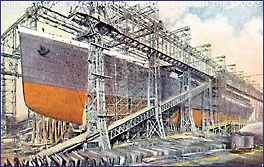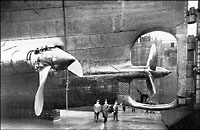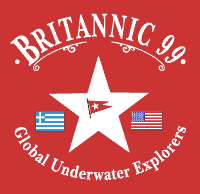|
Project Overview
On August 20, 1999 Global Underwater
Explorers will initiate the most complete and well-documented effort ever
attempted to explore the mysterious circumstances surrounding the sinking
of the Britannic - the world's largest shipwreck.
Project
Goals
- Exploration / Documentation
- Record-setting experience in deep exploration, coupled with advanced
Halcyon rebreather technology will provide divers with nearly unlimited
gas supply and the ability to explore distant sections of the Britannic.
State of the art still and three-chip digital video images will be recorded
on all dives in and around the wreck site.
- Survey - Extended
exploration of the Britannic will allow detailed structural surveys
and help to illuminate the circumstances that contributed to the sinking
of both the Titanic and the Britannic by identifying the cause of the
explosion and possible structural defects. Diver propulsion vehicles
and side scan sonar will be used to survey the area around the ship
to locate the debris field and possible evidence that will help to determine
the cause of the explosion.
- Analysis - Metal
fragments will be collected from the location of the hull breach and
analyzed to determine whether structural defects and / or metal fatigue
contributed to the sinking.
Project Qualifications
Global Underwater Explorers
is uniquely positioned to conduct the most successful exploration and
documentation of the Britannic wreck site.
GUE project members include
an internationally renowned team of diving explorers who have attained
several world records through remarkable excursions into deep environments
while collecting survey and scientific data. Furthermore, significant
filming experience will allow the team to document this unprecedented
exploration of the wreckage for international media.
Historical Perspective
 Nearly
100 years after the sinking of the world's most luxurious liner, the Titanic
continues to captivate public sentiment. Yet the tragic mystery surrounding
the sinking of the Titanic becomes even more remarkable when taken together
with the fate of her larger and more enigmatic sister- the Britannic. Nearly
100 years after the sinking of the world's most luxurious liner, the Titanic
continues to captivate public sentiment. Yet the tragic mystery surrounding
the sinking of the Titanic becomes even more remarkable when taken together
with the fate of her larger and more enigmatic sister- the Britannic.
Weighing nearly 50 thousand
tons and just over 900 feet long,  the
Britannic was approximately 20 feet longer than the Titanic. The ship
was originally to be named the Gigantic. However, to avoid association
with the unfortunate demise of the Titanic, the White Star Line changed
her name to the more patriotic and appealing Britannic. Plans to outfit
her with greater opulence than her infamous sibling were forsaken when
wartime requisition dressed her as a hospital ship and forever altered
her fate as a luxury liner. the
Britannic was approximately 20 feet longer than the Titanic. The ship
was originally to be named the Gigantic. However, to avoid association
with the unfortunate demise of the Titanic, the White Star Line changed
her name to the more patriotic and appealing Britannic. Plans to outfit
her with greater opulence than her infamous sibling were forsaken when
wartime requisition dressed her as a hospital ship and forever altered
her fate as a luxury liner.
The Mystery
of the Britannic's Sinking
On November 21, 1916, just
over four and one half years after the loss of the Titanic and a little
over 18 months after the torpedoing of the Lusitania, the British hospital
ship HMHS Britannic was sunk. On her sixth voyage as she passed the Greek
island of Kea, an unexplained explosion sent her to the bottom of the
Aegean Sea in a mere 55 minutes. Despite some allegations that a German
U-boat had deliberately torpedoed her, the largest British passenger ship
at that time almost certainly had struck a mine. Or had she?
Although only 30 of the more
than 1,000 hospital staff and crewmembers were killed, the loss of the
ship caused considerable concern. Many survivors stipulated that they
had seen torpedo tracks prior to the explosion, lending credence to the
belief that the Britannic had not hit a mine but had in fact been the
victim of German aggression. Also, despite the numerous and costly improvements
after the loss of the Titanic, the Britannic sank with amazing rapidity.
In 1975, underwater explorer
Jacques Cousteau located the Britannic in 400 feet of water. Closer inspection
the following year revealed the wreck to be lying on its starboard side
with a large hole visible in the port side through to the seabed. Interestingly,
the steel plate around this hole was bent outward, despite the fact that
the mine had reportedly detonated to starboard, leading to speculation
that a secondary explosion from an unknown cause had occurred. Controversy
persists as to whether this hospital ship was secretly carrying munitions
or whether she was the innocent victim of a secondary explosion from another
source.
Only additional exploration
of this gigantic wreck can determine whether a torpedo or a mine initiated
her descent to the bottom of the Aegean Sea. And, only careful study can
determine if, in fact, a second explosion hastened her sinking.
Diving Logistics
 Extreme
depth and occasionally fierce currents complicate safe access to the Britannic,
requiring significant diving skill and detailed operations planning to
complete a successful project. Global Underwater Explorers consists of
some of the world's most accomplished divers well versed in a wide variety
of extreme environments. Furthermore, each team of divers contains an
accomplished photographer and/or videographer allowing for extensive project
documentation. Extreme
depth and occasionally fierce currents complicate safe access to the Britannic,
requiring significant diving skill and detailed operations planning to
complete a successful project. Global Underwater Explorers consists of
some of the world's most accomplished divers well versed in a wide variety
of extreme environments. Furthermore, each team of divers contains an
accomplished photographer and/or videographer allowing for extensive project
documentation.
Permitting
Process
Obtaining diving access to
the Britannic is a difficult and politically sensitive process. Global
Underwater Explorers is one of only four organizations to be permitted
access to the shipwreck. Because it is considered a war grave by the British
government, diving is strictly regulated. Furthermore, access to the Britannic
must be obtained from both the British owner and the Greek government
as the ship lies in Greek territorial water.
Access to the wreck is granted
no more than one time each year and is limited to only the most qualified
organizations. Since its 1975 discovery, only three groups have been awarded
permission to access the Britannic, all operating under a limited time
window with very limited resources. Success of the project is promoted
by the fact that Britannic '99 will be the first project conducted by
an active exploration team accustomed to deep diving excursions.
| 
